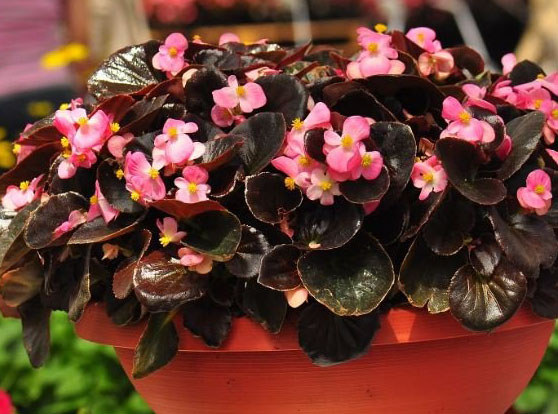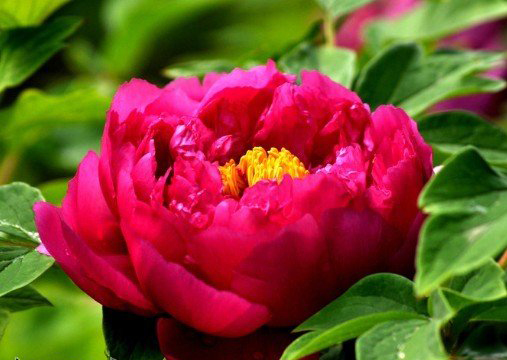Control methods of Blight of Begonia in four Seasons
The blight of Begonia in four seasons is a common disease of Begonia in four seasons, which occurs in flower farms and family potted crabapple. It mainly harms the leaves at the base of the stem and near the soil surface. In the early stage of the disease, the base of the stem near the soil was infected with dark spots, which became brown and rotten after expansion. The leaves are infected with dark green waterlogging-like round spots and brown rot when infecting the petiole. In the morning with high humidity, it can be seen that the disease spot has white to light brown filaments. Seriously diseased plants lodge or rot and die.
The pathogen overwinters with mycelium or sclerotia in the diseased tissue or in the soil. Begonia ramets or cuttings cause damage to □, when the temperature is 20-24 degrees Celsius, the humidity is high, or in overcast and rainy weather, too much watering, the bacteria invade and often cause the disease to occur seriously.

Prevention and cure method
(l) soilless cultivation is adopted. Compost made by retting with enzyme bacteria is recommended for soil cultivation. Select new soil rich in organic matter or pond mud, river mud and so on to prepare basin soil.
(2) remove the diseased leaves in time and strengthen ventilation.
(3) disinfect the soil conditionally, use 40% pentachlorothiram or seed-mixed double powder, the dosage is 8g per cup, mix well with the soil and put it into a basin and set aside.
(4) at the initial stage of the disease, 95% Luheng l was sprayed with 3000 times solution or 20% methyl rifampicin EC 1,200 times, 50% Likuling wettable powder 1000 times, potassium permanganate l200~l300 times.
(5) after the onset of the disease, 40% pentachlorothiram or seed dressing powder plus fine sand can also be used to form a 200-fold drug soil, and l00~l50g is applied to each plant or pot, once every l0~l5 day.
(6) the spread of the disease can be effectively controlled by using 0.4 kg 0.45 kg of cultured Penicillium harzianum, adding 50 kg fine soil, mixing well and sprinkling it on the base of the diseased plant. Begonia is sensitive to fungicides, and some new varieties need to be tried before being used on a large scale.
The control method of Begonia blight in four seasons is one of the common diseases of begonia in four seasons, which occurs in flower farms and family potted begonia. It mainly harms the leaves at the base of the stem and near the soil surface. In the early stage of the disease, the base of the stem near the soil was infected with dark spots, which became brown and rotten after expansion. The leaves are infected with dark green waterlogging-like round spots and brown rot when infecting the petiole. In the morning with high humidity, it can be seen that the disease spot has white to light brown filaments. Seriously diseased plants lodge or rot and die. The pathogen overwinters with mycelium or sclerotia in the diseased tissue or in the soil. When Begonia is divided or propagated by cuttings, the wound is caused by the temperature of 20-24 ℃, high humidity or excessive watering in overcast and rainy weather, the pathogen invades and often causes the disease to occur seriously. Control methods (1) soilless cultivation was adopted. Compost made by retting with enzyme bacteria is recommended for soil cultivation. Select new soil rich in organic matter or pond mud, river mud and so on to prepare basin soil. (2) remove the diseased leaves in time and strengthen ventilation. (3) disinfect the soil conditionally, use 40% pentachlorothiram or seed-mixed double powder, the dosage is 8g per cup, mix well with the soil and put it into a basin and set aside. (4) at the initial stage of the disease, 95% Luheng No. 1 was sprayed with 3000 times liquid or 20% methyl rifampicin EC 1200 times, 50% Likuling wettable powder 1000 times, potassium permanganate 1200 times. (5) after the onset of the disease, 40% pentachlorothiram or seed dressing powder plus fine sand can also be used to form a drug soil of 200 times, with 100g / 150g per plant or pot, once every 10 to 15 days. (6) the spread of Trichoderma harzianum can be effectively controlled by using cultured Trichoderma harzianum 0.4~0.45kg, adding 50kg fine soil, mixing and sprinkling on the base of the diseased plant. Begonia is sensitive to fungicides, and some new varieties need to be tried before being used on a large scale. What are the control methods of Begonia blight in four seasons? Begonia blight is one of the common diseases of begonia in four seasons, which occurs in flower farms and family potted crabapple. It mainly harms the leaves at the base of the stem and near the soil surface. In the early stage of the disease, the base of the stem near the soil was infected with dark spots, which became brown and rotten after expansion. The leaves are infected with dark green waterlogging-like round spots and brown rot when infecting the petiole. In the morning with high humidity, it can be seen that the disease spot has white to light brown filaments. Seriously diseased plants lodge or rot and die. The pathogen overwinters with mycelium or sclerotia in the diseased tissue or in the soil. When Begonia is divided or propagated by cuttings, the wound is caused by the temperature of 20-24 ℃, high humidity or excessive watering in overcast and rainy weather, the pathogen invades and often causes the disease to occur seriously. Prevention and control methods: (1) soilless cultivation was adopted. Compost made by retting with enzyme bacteria is recommended for soil cultivation. Select new soil rich in organic matter or pond mud, river mud and so on to prepare basin soil. (2) remove the diseased leaves in time and strengthen ventilation. (3) disinfect the soil conditionally, use 40% pentachlorothiram or seed-mixed double powder, the dosage is 8g per cup, mix well with the soil and put it into a basin and set aside. (4) at the initial stage of the disease, 95% Luheng No. 1 was sprayed with 3000 times liquid or 20% methyl rifampicin EC 1200 times, 50% Likuling wettable powder 1000 times, potassium permanganate 1200 times. (5) after the onset of the disease, 40% pentachlorothiram or seed dressing powder plus fine sand can also be used to form a drug soil of 200 times, with 100g / 150g per plant or pot, once every 10 to 15 days. (6) the spread of Trichoderma harzianum can be effectively controlled by using cultured Trichoderma harzianum 0.4~0.45kg, adding 50kg fine soil, mixing and sprinkling on the base of the diseased plant. Begonia is sensitive to fungicides, and some new varieties need to be tried before being used on a large scale. Through the detailed introduction of this article, I hope you can gain something. Thank you for your attention and support to Zuihua Network!
- Prev

Control methods of Dragon Blood Tree Tip Blight
Dragon blood tree tip blight is mainly harmful to the lower leaves. After the leaf tip is infected, the leaf tip expands into the leaf, the disease spot becomes straw yellow and sunken, there is a brown line at the junction between the disease and health, and there are many small black spots in the disease. Leaves often die of disease, but the middle leaves die only at the tip, so it is called tip blight. Therefore, it has a very direct impact on the viewing effect.
- Next

The main reason why peony leaves are easy to burn
Summer temperature is on the high side, peony leaves by strong light irradiation, sometimes there will be leaf tip, leaf edge yellow dry phenomenon. According to the observation and analysis of many years, the author talks about its causes and preventive measures. The reason for the dry tip and dry edge of peony leaves 1. The alkaline soil of the soil reduces the absorption of water and nutrients by peony roots
Related
- Fuxing push coffee new agricultural production and marketing class: lack of small-scale processing plants
- Jujube rice field leisure farm deep ploughing Yilan for five years to create a space for organic food and play
- Nongyu Farm-A trial of organic papaya for brave women with advanced technology
- Four points for attention in the prevention and control of diseases and insect pests of edible fungi
- How to add nutrient solution to Edible Fungi
- Is there any good way to control edible fungus mites?
- Open Inoculation Technology of Edible Fungi
- Is there any clever way to use fertilizer for edible fungus in winter?
- What agents are used to kill the pathogens of edible fungi in the mushroom shed?
- Rapid drying of Edible Fungi

